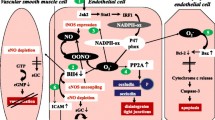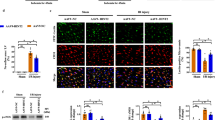Summary
We assessed the effects of the calcium channel blocker verapamil on postischemic oxidative injury in the rat liver. In the untreated rats, the values of tissue lipid peroxidation products (thiobarbituric acid-reactive substances) remained unchanged during 90 min of warm ischemia. However, the values increased significantly after the next 60 min of reperfusion compared with those in the sham-operated rats (P<0.01). Intravenous infusion of verapamil (5 μg·kg−1 ·min−1) significantly reduced the extent of lipid peroxidation during reperfusion compared with that in the untreated rats (P<0.02). The percentages of tissue water content and the serum lactate dehydrogenase activities after 60 min of reperfusion were significantly lower in the treated rats than in the untreated rats (P<0.02 andP<0.01, repsectively). We also investigated the influence of verapamil on superoxide-generating activity determined by the superoxide-dependent cytochromec reduction of peritoneal polymorphonuclear leukocytes (PMNs) harvested from normal, non-ischemic, and non-treated rats in vitro. This demonstrated that there was no apparent effect with the highest verapamil concentration level (8μM) observed in the rat plasma during our experiment. These findings suggest that verapamil might reduce the postischemic oxidative injury in the rat liver by mechanisms perhaps not related to the suppression of rat PMNs superoxide-generating activity.
Similar content being viewed by others
References
Ar'Rajab A, Ahren BO, Bengmark S (1991) Improved liver preservation for transplantation due to calcium channel blockade. Transplantation 51:965–967
Asakawa H, Jeppsson B, Mack B, Hultberg B, Hagerstrand I, Bengmark S (1989) Acute ischemic liver failure in the rat: a reproducible model not requiring portal decompression. Eur Surg Res 21:42–48
Bergmeyer HU, Kreutz FH, Pilz W, Schmidt FW, Büttner H, Lang H, Rick W, Stamm D, Hillmann G, Laue D, Schmidt E, Szasz G (1972) Empfehlungen der Deutschen Gesellschaft für Klinische Chemie. Z Klin Chem Klin Biochem 10:182–192
Bors W, Buettner GR, Michel C, Saran M (1990) Calcium in lipid peroxidation: does calcium interact with superoxide? Arch Biochem Biophys 278:269–272
Bradford M (1976) A rapid and sensitive method for the quantitation of microgram quantities of protein utilizing the principle of protein-dye binding. Anal Biochem 72:248–254
Castagna M, Takai Y, Kaibuchi K, Sano K, Kikkawa U, Nishizuka Y (1982) Direct activation of calcium-activated, phospholipid-dependent protein kinase by tumor-promoting phorbol esters. J Biol Chem 257:7847–7851
Cheng S, Ragsdale JR, Sasaki AW, Lee RG, Deveney CW, Pinson W (1991) Verapamil improves rat hepatic preservation with UW solution. J Surg Res 50:560–564
Cheung WY (1980) Calmodulin plays a pivotal role in cellular regulation. Science 207:19–27
Chenung JY, Bonventre JV, Malis CD, Leaf A (1986) Calcium and ischemic injury. N Engl J Med 314:1670–1675
Chien KR, Abrams J, Pfau RG, Farber JL (1977) Prevention by chlorpromazine of ischemic liver cell death. Am J Pathol 88:539–557
Cotterill LA, Gower JD, Fuller BJ, Green CJ (1989) Oxidative damage to kidney membranes during cold ischemia. Transplantation 48:745–751
Dahm LJ, Hewett JA, Roth RA (1988) Bile and bile salts potentiate superoxide anion release from activated, rat peritoneal neutrophils. Toxicol Appl Pharmacol 95:82–92
Engerson TD, McKelvey TG, Rhyne DB, Boggio EB, Snyder SJ, Jones HP (1987) Conversion of xanthine dehydrogenase to oxidase in ischemic rat tissues. J Clin Invest 79:1564–1570
Goldfarb D, Iaina A, Serban I, Gavendo S, Kapuler S, Eliahou HE (1983) Beneficial effect of verapamil in ischemic acute renal failure in the rat. Proc Soc Exp Biol Med 172:389–392
Halliwell B (1987) Oxidants and human disease: some new concepts. FASEB J 1:358–364
Hof RP (1983) Calcium antagonists and the peripheral circulation: differences and similarities between PY 108-068, nicardipine, verapamil and diltiazem. Br J Pharmacol 78:375–394
Hoshino T, Maley WR, Bulkley GB, Williams GM (1988) Ablation of free radical-mediated reperfusion injury for the salvage of kidneys taken from non-heartbeating donors. Transplantation 45:284–289
Irita K, Fujita I, Takeshige K, Minakami S, Yoshitake J (1986) Calcium channel antagonist induced inhibition of superoxide production in human neutrophils. Biochem Pharmacol 35:3465–3471
Ishii K, Suita S, Sumimoto H (1990) Effect of verapamil on conversion of xanthine dehydrogenase to oxidase in ischemic rat liver. Res Exp Med 190:389–399
Kuwada M, Tateyama T, Tsutsumi J (1981) Simultaneous determination of verapamil and its seven metabolites by high performance liquid chromatography. J Chromatogr 222:507–511
Linas SL, Shanley PF, Whittenburg D, Berger E, Repine JE (1988) Neutrophils accentuate ischemia-reperfusion injury in isolated perfused rat kidneys. Am J Physiol 255:F728–735
Marubayasi S, Takenaka M, Dohi K, Ezaki H, Kawasaki T (1980) Adenine nucleotide metabolism during hepatic ischemia and subsequent blood reflow periods and its relation to organ viability. Transplantation 30:294–296
McCord JM (1985) Oxygen-derived free radicals in postischemic tissue injury. N Engl J Med 312:159–163
Nauta RJ, Tsimoyiannis E, Uribe M, Walsh DB, Miller D, Butterfield A (1991) The role of calcium ions and calcium channel entry blockers in experimental ischemia-reperfusion-induced liver injury. Ann Surg 213:137–142
Otamiri T (1989) Oxygen radicals, lipid peroxidation, and neutrophil infiltration after small intestinal ischemia and reperfusion. Surgery 105:593–597
Paterson IS, Klausner JM, Goldman G, Kobzik L, Welbourn R, Valeri CR, Shepro D, Hechtman HB (1989) Thromboxane mediates the ischemia-induced neutrophil oxidative burst. Surgery 106:224–229
Reimer KA, Jennings RB (1982) Ion and water shifts cellular. In: Cowley RA, Trump BF (eds) Pathophysiology of shock, anoxia, and ischemia, Williams & Wilkins, Baltimore, p 132
Reiter MJ, Shand DG, Pritchett ELC (1982) Comparison of intravenous and oral verapamil dosing. Clin Pharmacol Ther 32:711–720
Romani F, Vertemati M, Frangi M, Aseni P, Monti R, Codeghini A, Belli L (1988) Effect of superoxide dismutase on liver ischemia-reperfusion injury in the rat: a biochemical monitoring. Eur Surg Res 20:335–340
Shinohara M, Kayashima K, Konomi K (1990) Protective effects of verapamil on ischemia-induced hepatic damage in the rat. Eur Surg Res 22:256–262
Simchowitz L, Spilberg I (1979) Generation of superoxide radicals by human peripheral neutrophils activated by chemotactic factor. Evidence for the role of calcium. J Lab Clin Med 93:583–593
Slater TF (1983) Overview of methods used for detecting lipid peroxidation. In: Packer L (ed) Oxygen radicals in biological systems. Methods Enzymol 105:283
Stein HJ, Fayman MS, Oosthuizen MMJ, Hinder RA (1989) Verapamli improves survival of rat skin flaps. Surgery 106:617–623
Thurman RG, Apel E, Badr M, Lemasters JL (1988) Protection of liver by calcium entry blockers. Ann NY Acad Sci 522:757–770
Uchiyama M, Mihara M (1978) Determination of malonaldehyde precursor in tissues by thiobarbituric acid test. Anal Biochem 86:271–278
Author information
Authors and Affiliations
Rights and permissions
About this article
Cite this article
Ishii, K., Arima, T. & Suita, S. Verapamil attenuates postischemic oxidative injury in the rat liver. Res. Exp. Med. 192, 151–159 (1992). https://doi.org/10.1007/BF02576270
Received:
Accepted:
Issue Date:
DOI: https://doi.org/10.1007/BF02576270




